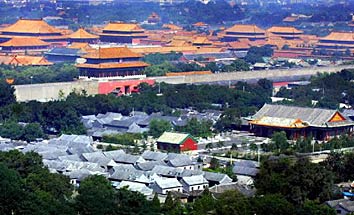An international forum entitled Architectural Art -- Protection
of Human Relics and Attention to Historical and Cultural Cities,
Towns and Villages was held in Beijing early in June. Issues
discussed during its three-day meeting include how to protect the
World Heritage sites in China continuously and effectively and the
planning of the first group of historical and cultural towns.
China's ancient cities are unique in architectural style and
have great historical and cultural values. Xie Chensheng, former
adviser to the State Administration of Cultural Heritage and
honorary president of the Chinese Society of Cultural Relics,
believes that by being listed as World Cultural Heritage sites,
historical sites and cultural relics can get better protection.

He took the
Imperial City in Beijing as an example. Although many modern
architectures have been built, the main sites, such as the
Forbidden City, the Coal Hill, the lakes of Shichahai and Beihai,
the street of Nanchizi and the numerous mansions of princes, are
well-protected. In addition, the Imperial Temple of Emperors is to
be repaired this year. If the Imperial City in Beijing, plus the
White Pagoda Temple, can apply for being listed as World Cultural
Heritage sites in one package, they have better chance to win.
Xie said China now has 101 historical and cultural cities, which
represent the nation's glorious culture. Unfortunately, only a few
of these cities, such as Lijiang of
Yunnan
Province, Pingyao of
Shanxi
Province and Hancheng of
Shaanxi
Province, have been well preserved; others have been damaged
more or less. In some cities, destruction took place even after the
State Council announced them as national historical and cultural
cities. Anyang of
Henan
Province, for example, tore down large patches of its ancient
buildings to give room for modern construction after the State
Council designated the city a historical and cultural city.

According to Zheng
Xiaoxie, vice chairman of the National Specialists Committee for
the Protection of Historical and Cultural Cities, not many local
governments have recognized the importance to protect ancient
cities. Many of them don't know how to handle properly the
relationships between tourism and the protection of cultural
relics. Even worse, some of the cities are tapping their tourism
resources for economic benefits only.
The Beijing municipal government has been working hard on
protecting the city's cultural relics. It has taken two most
effective measures: compiling the General Plan for the City of
Beijing and working out the Regulations on the Protection of the
Historical and Cultural City.

According to the
"General Plan," the city planning shall follow the principle of
"two axes, two zones and multiple centers." The two axes are the
Chang'an Boulevard running from east to west, crossing the city
center, and the thoroughfare of the Zhongzhou Road goes from south
to north. Divided by them, the west part of Beijing will be
retained as an ecological area while the east part being developed
into business area.
Constructions of various functioning facilities should be scattered
in the outskirts. A plan like this will greatly benefit the
protection of the Imperial City. It also offers favorable
conditions for the Imperial City to apply for the World Cultural
Heritage as a package.

The Forbidden
City, which is the center of the Imperial City, has already been
listed as a World Cultural Heritage site. It is possible that it is
included in the new application.
Experts hold that many Chinese ancient cities should have
applied for entry on the World Cultural Heritage list. In recent
years, China has strengthened its protection of ancient cities. At
the same time, many valuable ancient cities have been found.
Phoenix in Hunan
Province, for example, is a well-protected old town matching
the honor of World Cultural Heritage.

(China.org.cn by Chen Lin, June 5, 2004)